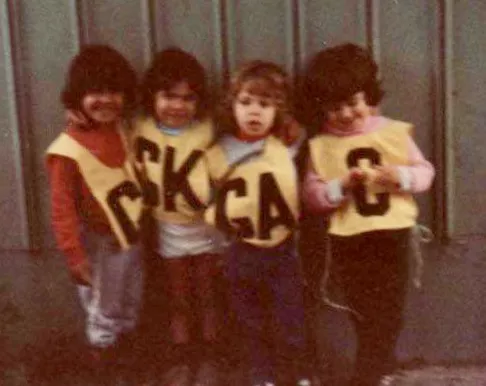As a netball-loving teenager, Rachael Stewart remembers her shyness, and feeling slightly overwhelmed when faced with what she calls the structures and standards that many of the non-Indigenous girls of her age “had been breathing since they were eight years old’’ (pictured in GA).
Stewart also recalls the joy of being a four-year-old putting on the uniform for her debut game, then posing with her cousins Lisa Thorpe and Jaynaya Atkinson and Aunty Laura Thompson for a photograph she still treasures.
Now, almost four decades later, the mother of six (plus seven stepchildren) and one of the co-founders of Southern Aboriginal Sports is committed to keeping more young people active and involved at the age and stage when so many drop out.
“We hope that it keeps them engaged and lights that fire in the belly,’’ says Stewart, whose organisation is focused on providing opportunities for young Aboriginal women and girls, through sports camps and other programs.
“We all know what it’s like to put your first bib on and play in your first game, and all that sort of stuff. So to keep that fire going, I think there needs to be more programs and opportunities and pathways from a young age. It’s important to have that installed.
“Sport is a vehicle that gets them from A to B. When kids are playing sport it’s instilling confidence, it’s meeting new people, it’s learning new skills. We believe that sport speaks a language that they understand. So there’s all these different components and that’s are why SAS was developed.’’
It was born out of the 2020 Covid-19 lockdowns, but the gestation period came over many years. When Stewart and her partner Michael Saunders were growing up in Echuca, the Yorta Yorta and Gunditjamara woman says Victorian Aboriginal Youth Sport and Recreation (VAYSAR) helped to provide the platform. The fact those opportunities have now been reduced, contributed to a need they are seeking to fill.
“We used to represent Victoria and play against South Australia,’’ Stewart says. "So Indigenous teams would get together around the state, we’d get selected and go and play other places and other communities.
“That doesn’t really exist any more and hasn’t probably for the last 20 years, and just the junior tournaments and carnivals, netball has only started in the last six years. So it’s like ‘they’re hungry for more, how can we provide that?’ And that’s sort of how we all come up with the idea.’’
“There wasn’t a platform for Indigenous kids in sport and we identified that gap, and that’s why we want Netball Victoria to be able to come to us and say ‘how does SAS help us get all these kids involved?’ And the same with AFL and basketball and all these other sports.’’
So, what are the benefits of Indigenous-specific competitions, as opposed to everyone being in this together? The question is asked genuinely, and the answer interesting.
“For us, it’s a celebration of culture, too,’’ says Stewart. “We call it like a modern-day corroboree, when we’re all together. A lot of us only see each other at Sorry Business and stuff like that; so how do we come together and celebrate as a whole? We also include non-Indigenous children in our tournaments and carnivals, we think that’s really important.
“But just to be able to build some self-confidence and to be able to feel safe and comfortable in that zone… yeah, it’s really hard to articulate (why). But I know when I used to go to the non-Indigenous ones I’d feel a bit overwhelmed, because it’s the standards we hadn’t been taught from a young age, as well. Some of the girls had been breathing that since they were eight years old.’’
The first Southern Aboriginal Sports venture is a junior basketball tournament in Dandenong during the June-July school holidays. Next will be a female sports camp - including netball - for 7-17-year-olds during the September break.
“What we realised is that we were losing numbers with girls’ participation at 15, 16, 17 - our boys’ (numbers) were always really high - and we identified that and that’s how we come up with SAS and these female camps,’’ says Stewart.
“We’ve had a lot of input and a lot of support. We’re community-driven, so we want to be able to go to communities and help them set up their own events and through the programs like the NetSetGO so really starting as young as we can.’’
Among the barriers Stewart identifies are the finances needed for registration, transport and uniforms, combined with social media and other distractions.
“I think there are all these different elements, and that’s why we want to bring them all together, especially in that female camp and to be able to find out what it is that makes them not want to participate at a certain age. I just feel that at 14-17 there is a real big drop-off. How do we identify why they are dropping off?’’
Shyness is one reason, and Stewart would know. Once upon a time that was her, too.
